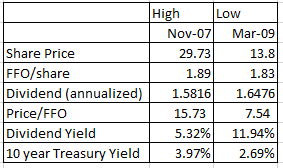Investor returns are a function of:
1. Dividends
2. FCF/Share Growth
3. Change in valuations
The first two items drive the fundamental return for investors. The last item is the speculative return.
It is important to understand where investor returns come from.
Let's illustrate this concept with an actual example, using Visa (V).
At the end of 2012, Visa $V stock sold at $37.90/share. The stock had a forward annual dividend of $0.33/share.
The company generated $1.74/share in Free Cash Flow.
The stock had a low yield of 0.87%, and a Price to FCF of 21.78.
In 2022, Visa generated $8.58 in FCF/share. The trailing 12-month FCF is at $10.52/share. The stock has a forward annual dividend of $2.08/share.
Visa yields 0.88% today. It sells for 22.50 times trailing FCF..
An investor who bought 1 share of Visa at the end of 2012, and reinvested dividends, would have 1.077665 shares today.
This $37.90 investment in Visa turned to $252.87
Going back to the formula for estimating returns, they are a function of:
1. Dividends
2. FCF/Share Growth
3. Change in Valuation Multiple
For Visa, between 2012 and today, the majority of returns in this case came from growth in FCF/Share from $1.74 to $10.52.
This drove growth in dividends, though dividends accounted for a smaller return than growth in FCF/Share.
The slight uptick in valuation contributed a miniscule amount to returns.
Going forward however, any thing could happen. There are various outcomes/possibilities.
For example, the business may still grow at a high pace over the next decade (though probably not by 500%).
However, a contraction in the valuation multiple could depress returns over a short period of time such as a decade
For example, if Visa generated $25/share in FCF in 2034, that would be a 137% increase in FCF/Share
However, if the business sells for only 10 times FCF, the share price would be $250. So that would be not much further from here, because the speculative return would be negative.
In that case, dividends would likely provide a higher level of returns, as yields would be higher and there would be less of a need for growth to generate returns.
The total investment return would be higher than the share price, because of the DRIP.
If the business sells for 20 times FCF, share prices would likely be driven by FCF/growth and Dividend reinvestment for the rest. The speculative return would be negative, but won't have much of a noticeable impact.
It is fascinating to look at the past history of FCF/EPS, Dividends, Valuations, and try to project onto the future, while also thinking of various scenarios. Note, I am not predicting anything, just trying to show how change in one variable could have a drastic impact.
For example, a business could operate at a steady rate of growth, but could generate great returns if the valuation multiple stays flat, but terrible returns if the valuation multiple shrinks. That's assuming we did a good job evaluating the fundamental characteristics of the business of course.
So even if we did a good job of evaluating a business, we have no idea what the multiple would be in a decade for example. It's just good to be aware that various outcomes are possible. This keeps us humble, and searching for ways to protect ourselves from future ignorance.
To me, this means diversification, and trying to avoid overpaying for a security. Sometimes, a security would get ahead of itself, and sell at a very high valuation. This depresses future returns, even if the business does as expected. On the other hand, the business may do well, while the security languishes for a long time. This increases future returns. It's therefore important to have some margin of safety. Easier said than done of course.
It also means building out positions slowly and overtime, while checking my thesis. It also means limiting how much I invest in a security. Reinvesting dividends elsewhere, versus DRIP is another risk management tool, as is keeping investment costs low.
Having an exit plan set out before the investment is purchased can be helpful as well
















